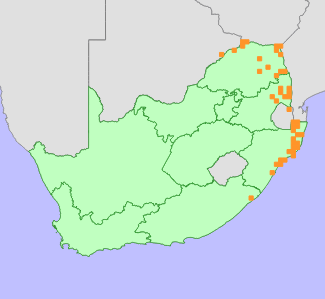| Scientific Name | Sesbania sesban (L.) Merr. subsp. sesban | Higher Classification | Dicotyledons | Family | FABACEAE | Common Names | Egyptian Sesban (e), Frother (e), Moseletsi (tw), Mpupunwa (v), Mugunwa (v), River Bean (e), Rivierboontjie (a), Umkhumukhweqe (z), Umsokosoko (z) |
National Status | Status and Criteria | Least Concern | Assessment Date | 2015/06/15 | Assessor(s) | D. van der Colff | Justification | Widespread and not in danger of extinction. |
Distribution | Endemism | Not endemic to South Africa | Provincial distribution | Eastern Cape, KwaZulu-Natal, Limpopo, Mpumalanga | Range | Venda southwards through the Mpumalanga Lowveld to northern KwaZulu-Natal, extending southwards along the coast as far as East London, Eastern Cape. Widespread further north in Africa. |
Habitat and Ecology | Major system | Terrestrial | Major habitats | Northern Coastal Forest, Makatini Clay Thicket, Western Maputaland Clay Bushveld, Nwambyia-Pumbe Sandy Bushveld, Western Maputaland Sandy Bushveld, Tembe Sandy Bushveld, Lebombo Summit Sourveld, Subtropical Alluvial Vegetation, Makuleke Sandy Bushveld, Zululand Coastal Thornveld, Swamp Forest, Lowveld Riverine Forest, Transkei Coastal Belt, Pondoland-Ugu Sandstone Coastal Sourveld, KwaZulu-Natal Coastal Belt Grassland, Maputaland Wooded Grassland, Maputaland Coastal Belt, Pretoriuskop Sour Bushveld, Legogote Sour Bushveld, Ngongoni Veld, Mopane Gabbro Shrubland, Phalaborwa-Timbavati Mopaneveld, Lowveld Rugged Mopaneveld, Tsende Mopaneveld, Mopane Basalt Shrubland, Cathedral Mopane Bushveld, Northern Zululand Sourveld, Musina Mopane Bushveld, Zululand Lowveld, Tzaneen Sour Bushveld, Gabbro Grassy Bushveld, Tshokwane-Hlane Basalt Lowveld, Delagoa Lowveld, Granite Lowveld, Maputaland Pallid Sandy Bushveld, KwaZulu-Natal Sandstone Sourveld, Limpopo Ridge Bushveld | Description | River margins, streambanks, floodplains, lake shores or other wet or swampy ground. Forms dense thickets in disturbed areas. |
Population | Population trend | Stable |
Assessment History |
Taxon assessed |
Status and Criteria |
Citation/Red List version | | Sesbania sesban (L.) Merr. subsp. sesban var. sesban | Least Concern | Raimondo et al. (2009) | | Sesbania sesban (L.) Merr. subsp. sesban var. nubica Chiov. | Least Concern | Raimondo et al. (2009) | | Sesbania sesban (L.) Merr. subsp. sesban var. zambesiaca J.B.Gillett | Least Concern | Raimondo et al. (2009) | |
Bibliography | Boon, R. 2010. Pooley's Trees of eastern South Africa. Flora and Fauna Publications Trust, Durban.
Brummitt, R.K., Harder, D.K., Lewis, G.P., Lock, J.M., Polhill, R.M. and Verdcourt, B. 2007. Leguminosae Subfamily Papilionoideae. In: J.R. Timberlake, R.M. Polhill, G.V. Pope and E.S. Martins (eds). Flora Zambesiaca 3 (Part 3):1-250. Royal Botanic Gardens, Kew.
Coates Palgrave, M. 2002. Keith Coates Palgrave Trees of southern Africa. 3rd Edition. Struik, Cape Town.
Gillett, J.B. 1963. Sesbania in Africa (excluding Madagascar) and southern Arabia. Kew Bulletin 17(1):91-159.
Raimondo, D., von Staden, L., Foden, W., Victor, J.E., Helme, N.A., Turner, R.C., Kamundi, D.A. and Manyama, P.A. 2009. Red List of South African Plants. Strelitzia 25. South African National Biodiversity Institute, Pretoria.
Schmidt, E., Lotter, M. and McCleland, W. 2002. Trees and shrubs of Mpumalanga and Kruger National Park. Jacana, Johannesburg.
Sieben, E.J.J. 2009. The status and distribution of vascular plants (Magnoliophyta, Lycophyta, Pteridophyta). In: W.R.T. Darwall, K.G. Smith, D. Tweddle and P. Skelton (eds.), The status and distribution of freshwater biodiversity in southern Africa (pp. 83-98), IUCN and SAIAB, Gland, Switzerland and Grahamstown, South Africa.
|
Citation | | van der Colff, D. 2015. Sesbania sesban (L.) Merr. subsp. sesban. National Assessment: Red List of South African Plants version 2024.1. Accessed on 2025/10/24 |
 Comment on this assessment Comment on this assessment
|
Search for images of Sesbania sesban subsp. sesban on iNaturalist
|
 Comment on this assessment
Comment on this assessment

